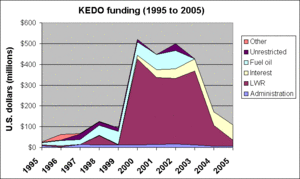Korean Peninsula Energy Development Organization facts for kids
 |
|
| Formation | March 15, 1995 |
|---|---|
| Founders | United States, South Korea, Japan |
| Location | |
| Fields | Nuclear power |
The Korean Peninsula Energy Development Organization (KEDO) was an international group. It was started on March 15, 1995. The main countries that created it were the United States, South Korea, and Japan. KEDO's big goal was to help North Korea. It aimed to stop North Korea from making nuclear weapons.
To do this, KEDO planned to build new, safer light water reactor nuclear power plants in North Korea. These new plants would replace older ones. The older plants were of a type called Magnox reactors. They were at the Yongbyon Nuclear Scientific Research Center. These older reactors were thought to be a step in a nuclear weapons program. The original plan was to finish the new plants by 2003.
KEDO's main office was in New York, United States. The organization officially closed down in 2006.
Contents
KEDO Members
After KEDO was first created, other countries and groups joined.
- 1995: Australia, Canada, New Zealand
- 1996: Argentina, Chile, Indonesia
- 1997: European Union, Poland
- 1999: Czech Republic
- 2000: Uzbekistan
Discussions within KEDO involved high-level officials. These included an Assistant Secretary of State from the U.S. and a deputy foreign minister from South Korea. Japan's Foreign Ministry also sent its head of the Asian bureau.
Building Nuclear Power Plants
| Country | U.S. dollars (millions) |
|---|---|
| South Korea | 1,455 |
| Japan | 498 |
| United States | 405 |
| European Atomic Energy Community |
122 |
| Australia | 14 |
| Others | 18 |
The official start of construction for the two light water reactors was on August 19, 1997. The building site was at Kumho, about 30 kilometers north of Sinpo in North Korea. This Kumho site had been chosen before. In the 1980s, the Soviet Union had promised to build similar reactors there.
Getting money for the project was difficult. Formal requests for bids to build the plants were not sent out until 1998. This caused delays, which made North Korea unhappy. A lot of money was not spent on the project until the year 2000. The first concrete was poured at the construction site on August 7, 2002. Both reactors were far behind their original schedule.
Project Challenges and End
The agreement that started KEDO began to fall apart in 2003. After this, KEDO largely lost its main purpose. KEDO then worked to protect the equipment and materials already bought for the power plant project. About $1.5 billion had been invested by this time.
The project was about 30% finished. One reactor's main building was about 50% complete. Another was about 15% finished. No key equipment for the reactors had been moved to the site.
In 2005, reports said that KEDO had agreed to stop the light-water reactor project. On January 9, 2006, it was announced that the project was officially over. Workers began returning to their home countries. North Korea asked for money as payment for the project ending. It also refused to return about $45 million worth of equipment left behind.
Executive Directors
- Stephen W. Bosworth, 1995–1997
- L. Desaix Anderson, 1997–2001
- Charles Kartman, 2001–2005
See also
- Division of Korea
- Six-party talks


